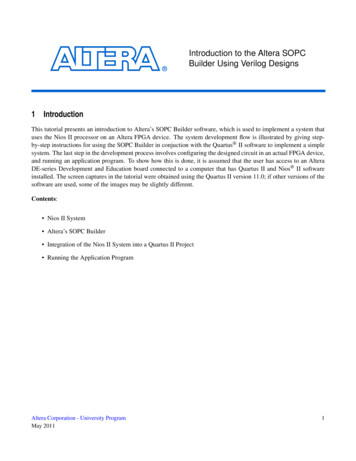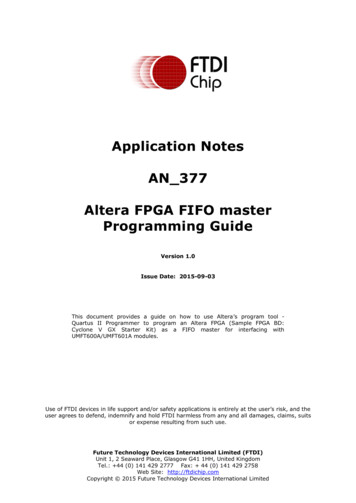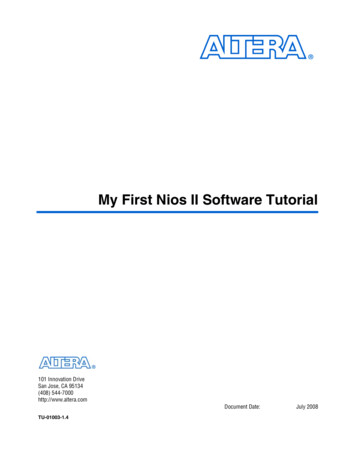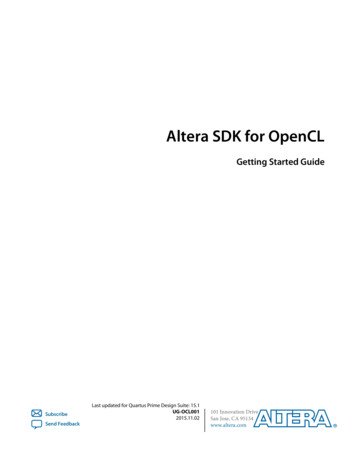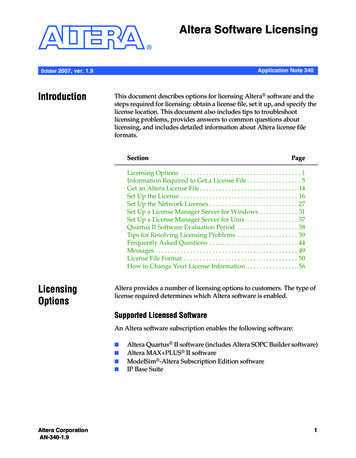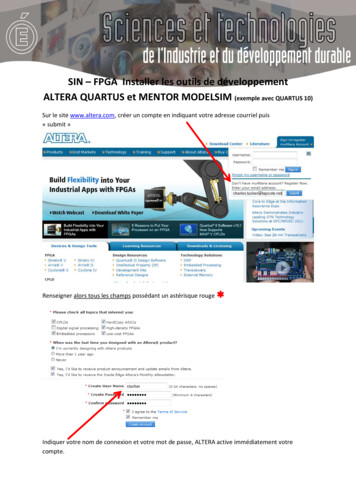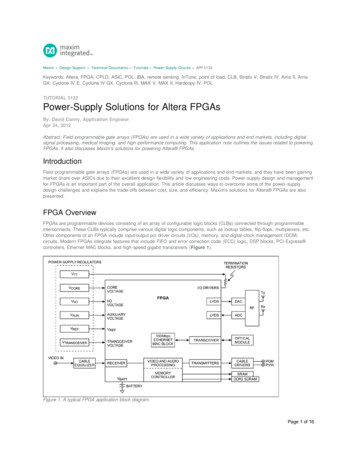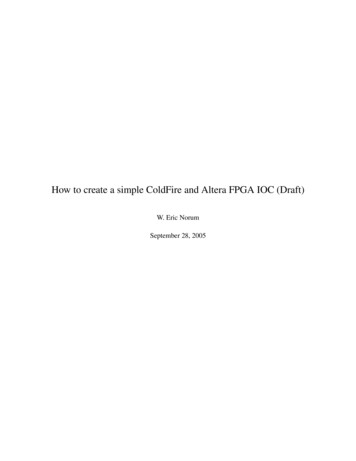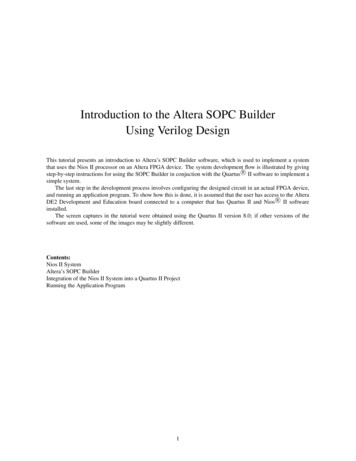
Transcription
Introduction to the Altera SOPC BuilderUsing Verilog DesignThis tutorial presents an introduction to Altera’s SOPC Builder software, which is used to implement a systemthat uses the Nios II processor on an Altera FPGA device. The system development flow is illustrated by givingstep-by-step instructions for using the SOPC Builder in conjuction with the Quartus R II software to implement asimple system.The last step in the development process involves configuring the designed circuit in an actual FPGA device,and running an application program. To show how this is done, it is assumed that the user has access to the AlteraDE2 Development and Education board connected to a computer that has Quartus II and Nios R II softwareinstalled.The screen captures in the tutorial were obtained using the Quartus II version 8.0; if other versions of thesoftware are used, some of the images may be slightly different.Contents:Nios II SystemAltera’s SOPC BuilderIntegration of the Nios II System into a Quartus II ProjectRunning the Application Program1
Altera’s Nios II is a soft processor, defined in a hardware description language, which can be implementedin Altera’s FPGA devices by using the Quartus R II CAD system. To implement a useful system it is necessaryto add other funcional units such as memories, input/output interfaces, timers, and communications interfaces.To facilitate the implementation of such systems, it is useful to have computer-aided-design (CAD) software forimplementing a system-on-a-programmable-chip (SOPC). Altera’s SOPC Builder is the software needed for thistask.This tutorial provides a basic introduction to Altera’s SOPC Builder, which will allow the reader to quicklyimplement a simple Nios II system on the Altera DE2 board. For a fuller treatment of the SOPC Builder, thereader can consult the Nios II Hardware Development Tutorial. A complete description of the SOPC Builder canbe found in the Quartus II Handbook Volume 4: SOPC Builder. These documents are available on the Altera website.1 Nios II SystemA Nios II system can be implemented on the DE2 board as shown in Figure 1.Host computerUSB-BlasterinterfaceNios II processorJTAG DebugmoduleJTAG UARTinterfaceCyclone IIFPGA chipAvalon switch hmemoryinterfaceParallel I/OinterfaceSerial elI/O portlinesSerialI/O portlinesFigure 1. A Nios II system implemented on the DE2 board.2
The Nios II processor and the interfaces needed to connect to other chips on the DE2 board are implementedin the Cyclone II FPGA chip. These components are interconnected by means of the interconnection networkcalled the Avalon Switch Fabric. The memory blocks in the Cyclone II device can be used to provide an on-chipmemory for the Nios II processor. The SRAM, SDRAM and Flash memory chips on the DE2 board are accessedthrough the appropriate interfaces. Parallel and serial input/output interfaces provide typical I/O ports used incomputer systems. A special JTAG UART interface is used to connect to the circuitry that provides a UniversalSerial Bus (USB) link to the host computer to which the DE2 board is connected. This circuitry and the associatedsoftware is called the USB-Blaster. Another module, called the JTAG Debug module, is provided to allow the hostcomputer to control the Nios II system. It makes it possible to perform operations such as downloading programsinto memory, starting and stopping execution, setting breakpoints, and collecting real-time execution trace data.Since all parts of the Nios II system implemented on the FPGA chip are defined by using a hardware description language, a knowledgeable user could write such code to implement any part of the system. This would bean onnerous and time consuming task. Instead, one can use the SOPC Builder to implement a desired systemsimply by choosing the required components and specifying the parameters needed to make each component fitthe overall requirements of the system. In this tutorial, we will illustrate the capability of the SOPC Builder bydesigning a very simple system. The same approach is used to design large systems.Host computerReset nUSB-BlasterinterfaceClockNios II processorJTAG DebugmoduleJTAG UARTinterfaceAvalon switch fabricOn-chipmemorySwitchesparallel inputinterfaceSW7SW0LEDsparallel outputinterfaceLEDG7Figure 2. A simple example of a Nios II system.3LEDG0Cyclone IIFPGA chip
Our example system is given in Figure 2. The system realizes a trivial task. Eight toggle switches on the DE2board, SW 7 0, are used to turn on or off the eight green LEDs, LEDG7 0. The switches are connected to theNios II system by means of a parallel I/O interface configured to act as an input port. The LEDs are driven by thesignals from another parallel I/O interface configured to act as an output port. To achieve the desired operation, theeight-bit pattern corresponding to the state of the switches has to be sent to the output port to activate the LEDs.This will be done by having the Nios II processor execute a program stored in the on-chip memory. Continuousoperation is required, such that as the switches are toggled the lights change accordingly.We will use the SOPC Builder to design the hardware depicted in Figure 2. Next, we will assign the Cyclone IIpins to realize the connections between the parallel interfaces and the switches and LEDs which act as I/O devices.Then, we will configure the FPGA to implement the designed system. Finally, we will use the software tool calledthe Nios II Monitor Program to assemble, download and execute a Nios II program that performs the desired task.Doing this tutorial, the reader will learn about: Using the SOPC Builder to design a Nios II-based system Integrating the designed Nios II system into a Quartus II project Implementing the designed system on the DE2 board Running an application program on the Nios II processor2 Altera’s SOPC BuilderThe SOPC Builder is a tool used in conjuction with the Quartus II CAD software. It allows the user to easilycreate a system based on the Nios II processor, by simply selecting the desired functional units and specifyingtheir parameters. To implement the system in Figure 2, we have to instantiate the following functional units: Nios II processor, which is referred to as a Central Processing Unit (CPU) On-chip memory, which consists of the memory blocks in the Cyclone II chip; we will specify a 4-Kbytememory arranged in 32-bit words Two parallel I/O interfaces JTAG UART interface for communication with the host computerTo define the desired system, start the Quartus II software and perform the following steps:1. Create a new Quartus II project for your system. As shown in Figure 3, we stored our project in a directorycalled sopc builder tutorial, and we assigned the name lights to both the project and its top-level designentity. You can choose a different directory or project name, but be aware that the SOPC Builder softwaredoes not permit the use of spaces in file names. For example, an attempt to use a directory name sopcbuilder tutorial would lead to an error. In your project, choose the EP2C35F672C6 chip as the target device,because this is the FPGA on the DE2 board.2. Select Tools SOPC Builder, which leads to the pop-up box in Figure 4. Enter nios system as the systemname; this will be the name of the system that the SOPC Builder will generate. Choose Verilog as the targetHDL, in which the system module will be specified. Click OK to reach the window in Figure 5.4
Figure 3. Create a new project.Figure 4. Create a new Nios II system.3. Figure 5 displays the System Contents tab of the SOPC Builder, which is used to add components to thesystem and configure the selected components to meet the design requirements. The available componentsare listed on the left side of the window. Before choosing our components, examine the area in the figurelabeled Target. Check the setting for the Device Family and ensure that Cyclone II is selected.4. The Nios II processor runs under the control of a clock. For this tutorial we will make use of the 50-MHzclock that is provided on the DE2 board. As shown in Figure 5, it is possible to specify the names andfrequency of clock signals in the SOPC Builder display. If not already included in this list, specify a clocknamed clk with the source designated as External and the frequency set to 50.0 MHz.5
Figure 5. The System Contents tab window.5. Next, specify the processor as follows: On the left side of the window in Figure 5 select Nios II Processor and click Add, which leads to thewindow in Figure 6.6
Figure 6. Create a Nios II processor. Choose Nios II/e which is the simplest version of the processor. Click Finish to return to the windowin Figure 5, which now shows the Nios II processor specified as indicated in Figure 7. There may besome warnings or error messages displayed in the SOPC Builder Messages window (at the bottom ofthe screen), because some parameters have not yet been specified. Ignore these messages as we willprovide the necessary data later.7
Figure 7. The defined processor.6. To specify the on-chip memory perform the following: Select Memories and Memory Controllers On-Chip On-Chip Memory (RAM or ROM) andclick Add In the On-Chip Memory Configuration Wizard window, shown in Figure 8, set the memory width to32 bits and the total memory size to 4 Kbytes Do not change the other default settings Click Finish, which returns to the System Contents tab as indicated in Figure 98
Figure 8. Define the on-chip memory.9
Figure 9. The on-chip memory is included.7. Specify the input parallel I/O interface as follows: Select Peripherals Microcontroller Peripherals PIO (Parallel I/O) and click Add to reach thePIO Configuration Wizard in Figure 10 Specify the width of the port to be 8 bits and choose the direction of the port to be Input, as shown inthe figure Click Finish to return to the System Contents tab as given in Figure 1110
Figure 10. Define a parallel input interface.Figure 11. The parallel input interface is included.11
8. In the same way, specify the output parallel I/O interface: Select Peripherals Microcontroller Peripherals PIO (Parallel I/O) and click Add to reach thePIO Configuration Wizard again Specify the width of the port to be 8 bits and choose the direction of the port to be Output Click Finish to return to the System Contents tab9. We wish to connect to a host computer and provide a means for communication between the Nios II systemand the host computer. This can be accomplished by instantiating the JTAG UART interface as follows: Select Interface Protocols Serial JTAG UART and click Add to reach the JTAG UART Configuration Wizard in Figure 12 Do not change the default settings Click Finish to return to the System Contents tabFigure 12. Define the JTAG UART interface.10. The complete system is depicted in Figure 13. Note that the SOPC Builder automatically chooses names forthe various components. The names are not necessarily descriptive enough to be easily associated with thetarget design, but they can be changed. In Figure 2, we use the names Switches and LEDs for the parallelinput and output interfaces, respectively. These names can be used in the implemented system. Right-clickon the pio name and then select Rename. Change the name to Switches. Similarly, change pio 1 to LEDs.11. The base and end addresses of the various components in the designed system can be assigned by the user,but they can also be assigned automatically by the SOPC Builder. We will choose the latter possibility. So,select the command (using the menus at the top of the SOPC Builder window) System Auto-AssignBase Addresses, which produces the assignment shown in Figure 14.12
Figure 13. The complete system.Figure 14. The final specification.13
12. The behaviour of the Nios II processor when it is reset is defined by its reset vector. It is the location inmemory device the processor fetches the next instruction when it is reset. Similarly, the exception vector isthe the memory address the processor goes to when an interrupt is raised. To specify these two parameters,perform the following: Right-click on the cpu and then select Edit to reach the window in Figure 15 Select onchip mem to be the memory device for both reset vector and exception vector, as shown inthe figure Do not change the default setting for offset Click Finish to return to the System Contents tabFigure 15. Define the reset vector and exception vector.13. Having specified all components needed to implement the desired system, it can now be generated. Selectthe System Generation tab, which leads to the window in Figure 16. Turn off Simulation - Createsimulator project files, because in this tutorial we will not deal with the simulation of hardware. ClickGenerate on the bottom of the SOPC Builder window. The generation process produces the messagesdisplayed in the figure. When the message “SUCCESS: SYSTEM GENERATION COMPLETED" appears,click Exit. This returns to the main Quartus II window.14
Figure 16. Generation of the system.Changes to the designed system are easily made at any time by reopening the SOPC Builder tool. Any component in the System Contents tab of the SOPC Builder can be selected and deleted, or a new component can beadded and the system regenerated.3 Integration of the Nios II System into a Quartus II ProjectTo complete the hardware design, we have to perform the following: Instantiate the module generated by the SOPC Builder into the Quartus II project Assign the FPGA pins Compile the designed circuit Program and configure the Cyclone II device on the DE2 board3.1Instantiation of the Module Generated by the SOPC BuilderThe instantiation of the generated module depends on the design entry method chosen for the overall Quartus IIproject. We have chosen to use Verilog HDL, but the approach is similar for both VHDL and schematic entrymethods.Normally, the Nios II module is likely to be a part of a larger design. However, in the case of our simpleexample there is no other circuitry needed. All we need to do is instantiate the Nios II system in our top-levelVerilog file, and connect inputs and outputs of the parallel I/O ports, as well as the clock and reset inputs, to theappropriate pins on the Cyclone II device.The Verilog module generated by the SOPC Builder is in the file nios system.v in the directory of the project.Note that the name of the Verilog module is the same as the system name specified when first using the SOPC15
Builder. The Verilog code is quite large. Figure 17 depicts the portion of the code that defines the input andoutput signals for the module nios system. The 8-bit vector that is the input to the parallel port Switches is calledin port to the Switches. The 8-bit output vector is called out port from the LEDs. The clock and reset signalsare called clk and reset n, respectively. Note that the reset signal is added automatically by the SOPC Builder; itis called reset n because it is active low.Figure 17. A part of the generated Verilog module.Figure 18 shows a top-level Verilog module that instantiates the Nios II system. This module is named lights,because this is the name we specified in Figure 3 for the top-level design entity in our Quartus II project. Notethat the input and output ports of the module use the pin names for the 50-MHz clock, CLOCK 50, pushbuttonswitches, KEY, toggle switches, SW, and green LEDs, LEDG, that are specified in the DE2 User Manual. Typethis code into a file called lights.v. Add this file and all the *.v files produced by the SOPC Builder to your QuartusII project. Also, add the necessary pin assignments on the DE2 board to your project. The procedure for makingpin assignments is described in the tutorial Quartus II Introduction Using Verilog Design. Note that an easy wayof making the pin assignments when we use the same pin names as in the DE2 User Manual is to import theassignments given in the file called DE2 pin assignments.csv in the directory DE2 tutorials\design files, whichis included on the CD-ROM that accompanies the DE2 board and can also be found on Altera’s DE2 web pages.Since the system we are designing needs to operate at a 50-MHz clock frequency, add the needed timing assignment in your Quartus II project. The tutorial Timing Considerations with Verilog-Based Designs shows howthis is done.16
// Implements a simple Nios II system for the DE2 board.// Inputs: SW7 0 are parallel port inputs to the Nios II system//CLOCK 50 is the system clock//KEY0 is the active-low system reset// Outputs: LEDG7 0 are parallel port outputs from the Nios II systemmodule lights (SW, KEY, CLOCK 50, LEDG);input [7:0] SW;input [0:0] KEY;input CLOCK 50;output [7:0] LEDG;// Instantiate the Nios II system module generated by the SOPC Builder:// nios system (clk, reset n, out port from the LEDs, in port to the Switches)nios system NiosII (CLOCK 50, KEY[0], LEDG, SW);endmoduleFigure 18. Instantiating the Nios II system.Having made the necessary settings compile the code. You may see some warning messages associated withthe Nios II system, such as some signals being unused or having wrong bit-lengths of vectors; these warnings canbe ignored.3.2Programming and ConfigurationProgram and configure the Cyclone II FPGA in the JTAG programming mode as follows:1. Connect the DE2 board to the host computer by means of a USB cable plugged into the USB-Blaster port.Turn on the power to the DE2 board. Ensure that the RUN/PROG switch is in the RUN position.2. Select Tools Programmer to reach the window in Figure 19.3. If not already chosen by default, select JTAG in the Mode box. Also, if the USB-Blaster is not chosen bydefault, press the Hardware Setup. button and select the USB-Blaster in the window that pops up.4. The configuration file lights.sof should be listed in the window. If the file is not already listed, then clickAdd File and select it.5. Click the box under Program/Configure to select this action.6. At this point the window settings should appear as indicated in Figure 19. Press Start to configure theFPGA.17
Figure 19. The Programmer window.4 Running the Application ProgramHaving configured the required hardware in the FPGA device, it is now necessary to create and execute an application program that performs the desired operation. This can be done by writing the required program either inthe Nios II assembly language or in a high-level language such as C. We will illustrate both approaches.A parallel I/O interface generated by the SOPC Builder is accessible by means of registers in the interface.Depending on how the PIO is configured, there may be as many as four registers. One of these registers is calledthe Data register. In a PIO configured as an input interface, the data read from the Data register is the datacurrently present on the PIO input lines. In a PIO configured as an output interface, the data written (by the NiosII processor) into the Data register drives the PIO output lines. If a PIO is configured as a bidirectional interface,then the PIO inputs and outputs use the same physical lines. In this case there is a Data Direction register included,which determines the direction of the input/output transfer. In our unidirectional PIOs, it is only necessary to havethe Data register. The addresses assigned by the SOPC Builder are 0x00003000 for the Data register in the PIOcalled Switches and 0x00003010 for the Data register in the PIO called LEDs, as indicated in Figure 14.You can find a full description of the PIO interface by opening the SOPC Builder window in Figure 14 andright-clicking on the module name of a PIO (either Switches or LEDs). Then, in the pop-up box select DataSheet to open the document PIO Core with Avalon Interface which gives a full description of the interface. Touse this facility you need to be connected to the Internet.4.1Using a Nios II Assembly Language ProgramFigure 20 gives a Nios II assembly-language program that implements our trivial task. The program loads theaddresses of the Data registers in the two PIOs into processor registers r2 and r3. It then has an infinite loop thatmerely transfers the data from the input PIO, Switches, to the output PIO, LEDs.The program includes the assembler directive.include "nios macros.s"which informs the Assembler to use the Nios II macros that specify how the movia pseudoinstructions can beassembled.18
.include "nios macros.s".equ.equSwitches, 0x00003000LEDs, 0x00003010.global startstart:moviamovialoop:ldbiostbiobrr2, Switchesr3, LEDsr4, 0(r2)r4, 0(r3)loopFigure 20. Assembly language code to control the lights.The directive.global startindicates to the Assembler that the label start is accessible outside the assembled object file. This label is thedefault label we use to indicate to the Linker program the beginning of the application program.For a detailed explanation of the Nios II assembly language instructions see the tutorial Introduction to theAltera Nios II Soft Processor.Enter this code into a file lights.s and place the file into a working directory. We placed the file into thedirectory sopc builder tutorial\app software. The program has to be assembled and converted into an S-Recordfile, lights.srec, suitable for downloading into the implemented Nios II system.Altera provides the monitor software, called Altera Monitor Program, for use with the DE2 board. Thissoftware provides a simple means for compiling, assembling and downloading of programs into a Nios II systemimplemented on a DE2 board. It also makes it possible for the user to perform debugging tasks. A description ofthis software is available in the Altera Monitor Program tutorial.Open the Altera Monitor Program, which leads to the window in Figure 21. This software needs to know thecharacteristics of the designed Nios II system, which are given in the ptf file nios system.ptf. Click the Nios II Configure system. menu item to display the Nios II System Configuration window, shown in Figure 22, andperform the following steps:1. Select the USB-Blaster cable from the Cable drop-down list, which is used with DE2 board.2. Click Browse. to display a file selection window and choose the nios system.ptf file. Note that this file isin the design directory sopc builder tutorial.3. The Altera Monitor Program also needs to know where to load the application program. In our case, this isthe memory block in the FPGA device. The SOPC Builder assigned the name onchip mem to this block.As shown in Figure 22, the Monitor Program has already selected the correct memory device.4. Having provided the necessary information, click Ok to confirm the system configuration.Next, the source file lights.s needs to be specified. Click the Nios II Configure program. menu item todisplay the Nios II Program Configuration window in Figure 23 and perform the following steps:1. Click Add. to display a file selection window and choose the lights.s file. Note that this file is in thedirectory sopc builder tutorial\app software.2. Click Ok to confirm the program configuration.19
Next, to assemble and download the light.s program, click the Actions Compile & Load menu item. TheAltera Monitor Program will invoke an assembler program, followed by a linker program. The commands used toinvoke these programs, and the output they produce, can be viewed in the Info & Errors window of the MonitorProgram window. After the program has been downloaded onto the board, the program is displayed in the Disassembly window of the Monitor Program as illustrated in Figure 24. Observe that movia is a pseudoinstructionwhich is implemented as two separate instructions.Click the Actions Continue menu item to execute the program. With the program running, you can nowtest the design by turning the switches, SW 7 to SW 0 on and off; the LEDs should respond accordingly.Figure 21. The Altera Monitor Program window on startup.20
Figure 22. The Nios II System Configuration window.Figure 23. The Nios II Program Configuration window.21
Figure 24. Display of the downloaded program.The Monitor Program allows a number of useful functions to be performed in a simple manner. They include: single stepping through the program examining the contents of processor registers examining the contents of the memory setting breakpoints for debugging purposes disassembling the downloaded programA description of this software and all of its features is available in the Altera Monitor Program tutorial.4.2Using a C-Language ProgramAn application program written in the C language can be handled in the same way as the assembly-language program. A C program that implements our simple task is given in Figure 25. Enter this code into a file called lights.c.#define Switches (volatile char *) 0x0003000#define LEDs (char *) 0x0003010void main(){ while (1)*LEDs *Switches;}Figure 25. C language code to control the lights.22
Perform the following steps to use this program:1. Disconnect from the current debugging session by clicking the Actions Disconnect menu item.2. Click the Nios II Configure program. menu item to launch the Nios II Program Configuration window.3. Select C as the Program Type in the drop-down list.4. Select the lights.s file and click Remove to remove it from the list of source files.5. Click Add. and choose the lights.c file.6. Click Ok to confirm the new program configuration.The steps to compile, load, and run the program are the same as for an assembly language program.Copyright c 2008 Altera Corporation. All rights reserved. Altera, The Programmable Solutions Company, thestylized Altera logo, specific device designations, and all other words and logos that are identified as trademarksand/or service marks are, unless noted otherwise, the trademarks and service marks of Altera Corporation inthe U.S. and other countries. All other product or service names are the property of their respective holders.Altera products are protected under numerous U.S. and foreign patents and pending applications, mask workrights, and copyrights. Altera warrants performance of its semiconductor products to current specifications inaccordance with Altera’s standard warranty, but reserves the right to make changes to any products and services atany time without notice. Altera assumes no responsibility or liability arising out of the application or use of anyinformation, product, or service described herein except as expressly agreed to in writing by Altera Corporation.Altera customers are advised to obtain the latest version of device specifications before relying on any publishedinformation and before placing orders for products or services.This document is being provided on an “as-is” basis and as an accommodation and therefore all warranties, representations or guarantees of any kind (whether express, implied or statutory) including, without limitation, warranties of merchantability, non-infringement, or fitness for a particular purpose, are specifically disclaimed.23
the Nios II Monitor Program to assemble, download and execute a Nios II program that performs the desired task. Doing this tutorial, the reader will learn about: Using the SOPC Builder to design a Nios II-based system Integrating the designed Nios II system into a Quartus II project Implementing the designed system on the DE2 board


